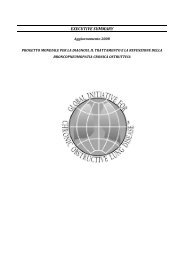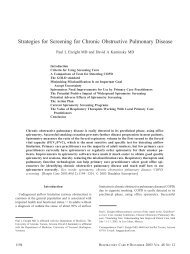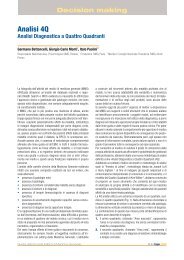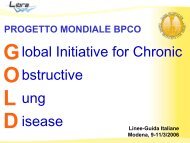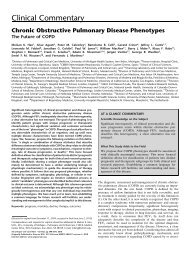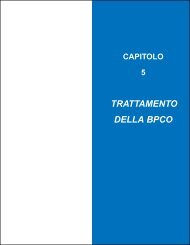Application of Number Needed to Treat (NNT) - GOLD
Application of Number Needed to Treat (NNT) - GOLD
Application of Number Needed to Treat (NNT) - GOLD
Create successful ePaper yourself
Turn your PDF publications into a flip-book with our unique Google optimized e-Paper software.
84 Cazzola<br />
THIS MANUSCRIPT IS PROVIDED IN CONFIDENCE TO DETERMINE REPRINT INTEREST ONLY AND SHOULD NOT BE DISTRIBUTED<br />
EITHER INTERNALLY OR EXTERNALLY VIA PRINT OR ELECTRONIC MEDIA FOR OTHER THAN THE STATED PURPOSE.<br />
more recently, the newer measure <strong>of</strong> number needed <strong>to</strong> screen in<br />
epidemiology.<br />
An additional potential benefit <strong>of</strong> <strong>NNT</strong> lies in the learning<br />
process that accompanies its adoption. The principles underlying<br />
calculation <strong>of</strong> <strong>NNT</strong> are easily unders<strong>to</strong>od and link in logically with<br />
the concepts <strong>of</strong> risk and effect <strong>of</strong> outcomes on such risk. Through<br />
the simple background research that is needed, clinicians wishing<br />
<strong>to</strong> apply clinical evidence <strong>to</strong> their practice can benefit from a<br />
greater understanding <strong>of</strong> how the parameters used <strong>to</strong> generate<br />
<strong>NNT</strong>s, relative and absolute risk, are calculated.<br />
As demonstrated in the present review, <strong>NNT</strong> is becoming more<br />
widely adopted in respira<strong>to</strong>ry medicine. Its recent endorsement by<br />
the Consolidated Standards <strong>of</strong> Reporting Trials (CONSORT)<br />
guidelines [36] means that <strong>NNT</strong> is likely <strong>to</strong> be used more frequently<br />
in the medical literature. Physicians are therefore encouraged <strong>to</strong><br />
consider <strong>NNT</strong> data alongside other established measures when<br />
selecting therapeutic interventions for respira<strong>to</strong>ry medicine.<br />
15. Halliday HL. Postnatal steroids and chronic lung disease in the newborn. Paediatr<br />
Respir Rev 2004; 5 Suppl. A: S245-8<br />
16. Stan<strong>to</strong>n WR, Lowe JB, M<strong>of</strong>fatt J, et al. Randomised control trial <strong>of</strong> a smoking<br />
cessation intervention directed at men whose partners are pregnant. Prev Med<br />
2004; 38: 6-9<br />
17. Shah SS, Ohlsson A, Halliday H, et al. Inhaled versus systemic corticosteroids for<br />
preventing chronic lung disease in ventilated very low birth weight preterm<br />
neonates. Cochrane Database Syst Rev 2003; (1): CD002058<br />
18. Ho JJ, Subramaniam P, Henderson-Smart DJ, et al. Continuous distending pressure<br />
for respira<strong>to</strong>ry distress syndrome in preterm infants. Cochrane Database Syst<br />
Rev 2002; (2): CD002271<br />
19. Davis PG, Henderson-Smart DJ. Extubation from low-rate intermittent positive<br />
airways pressure versus extubation after a trial <strong>of</strong> endotracheal continuous<br />
positive airways pressure in intubated preterm infants. Cochrane Database Syst<br />
Rev 2001; (4): CD001078<br />
20. Abramson MJ, Puy RM, Weiner JM. Allergen immunotherapy for asthma. Cochrane<br />
Database Syst Rev 2003; (4): CD001186<br />
21. Powell H, Gibson PG. Inhaled corticosteroid doses in asthma: an evidence-based<br />
approach. Med J Aust 2003; 178: 223-5<br />
22. Rowe BH, Spooner CH, Ducharme FM, et al. Corticosteroids for preventing<br />
relapse following acute exacerbations <strong>of</strong> asthma. Cochrane Database Syst Rev<br />
2001; (1): CD000195<br />
23. Charl<strong>to</strong>n BG. <strong>Number</strong>s needed <strong>to</strong> treat derived from meta-analysis: are an absurdity.<br />
BMJ 1999; 319: 1199<br />
Acknowledgments<br />
24. Smeeth L, Haines A, Ebrahim S. <strong>Number</strong>s needed <strong>to</strong> treat derived from metaanalyses:<br />
sometimes informative, usually misleading. BMJ 1999; 318: 1548-51<br />
25. D’Amico R, Deeks JJ, Altman DG. <strong>Number</strong>s needed <strong>to</strong> treat derived from meta-<br />
The author would like <strong>to</strong> thank AstraZeneca Italy for financial support.<br />
analysis: length <strong>of</strong> follow up is poorly reported. BMJ 1999; 319: 1200<br />
The author would also like <strong>to</strong> thank Adis International Ltd for assistance in the<br />
26. Hopayian K, McGough J. <strong>Number</strong>s needed <strong>to</strong> treat derived from meta-analysis:<br />
preparation <strong>of</strong> this manuscript. The author has received fees for speaking and using patient years may also be misleading. BMJ 1999; 319: 1199-200<br />
consulting and/or financial support for attending meetings from AstraZeneca<br />
27. Moore A, McQuay H. <strong>Number</strong>s needed <strong>to</strong> treat derived from meta analysis: <strong>NNT</strong> is<br />
and GlaxoSmithKline. a <strong>to</strong>ol, <strong>to</strong> be used appropriately. BMJ 1999; 319: 1200<br />
28. Jain BP. <strong>Number</strong> needed <strong>to</strong> treat and relative risk reduction. Ann Intern Med 1998;<br />
128: 72-3<br />
References<br />
29. Lui KJ. A simple logical solution <strong>to</strong> eliminate the limitations <strong>of</strong> using the number<br />
1. Fahey T, Griffiths S, Peters TJ. Evidence based purchasing: understanding results<br />
needed <strong>to</strong> treat. Eval Health Pr<strong>of</strong> 2004; 27: 206-14<br />
<strong>of</strong> clinical trials and systematic reviews. BMJ 1995; 311: 1056-9<br />
30. Halvorsen PA, Kristiansen IS. Decisions on drug therapies by numbers needed <strong>to</strong><br />
2. Forrow L, Taylor WC, Arnold RM. Absolutely relative: how research results are treat: a randomized trial. Arch Intern Med 2005; 165: 1140-6<br />
summarized can affect treatment decisions. Am J Med 1992; 92: 121-4<br />
31. Szafranski W, Cukier A, Ramirez A, et al. Efficacy and safety <strong>of</strong> budesonide/<br />
3. Malenka DJ, Baron JA, Johansen S, et al. The framing effect <strong>of</strong> relative and formoterol in the management <strong>of</strong> chronic obstructive pulmonary disease. Eur<br />
absolute risk. J Gen Intern Med 1993; 8: 543-8 Respir J 2003; 21: 74-81<br />
4. Naylor CD, Chen E, Strauss B. Measured enthusiasm: does the method <strong>of</strong> reporting<br />
32. Calverley PM, Boonsawat W, Cseke Z, et al. Maintenance therapy with budesonide<br />
trial results alter perceptions <strong>of</strong> therapeutic effectiveness? Ann Intern Med<br />
and formoterol in chronic obstructive pulmonary disease. Eur Respir J 2003;<br />
1992; 117: 916-21<br />
22: 912-9<br />
5. Evidence-Based Medicine Working Group. Evidence-based medicine: a new ap-<br />
33. Halpin D, Stahl E, Lundback B, et al. <strong>Treat</strong>ment costs and number needed <strong>to</strong> treat<br />
proach <strong>to</strong> teaching the practice <strong>of</strong> medicine. JAMA 1992; 268: 2420-5<br />
(<strong>NNT</strong>) with budesonide/formoterol <strong>to</strong> avoid one exacerbation <strong>of</strong> COPD [ab-<br />
6. Cook RJ, Sackett DL. The number needed <strong>to</strong> treat: a clinically useful measure <strong>of</strong><br />
stract plus poster]. In: 100 th International Conference <strong>of</strong> the American Thoracic<br />
treatment effect. BMJ 1995; 310: 452-4<br />
Society; 2004 May 21-26; Florida. Am J Respir Crit Care Med 2004 May; 169<br />
7. McQuay HJ, Moore RA. Using numerical results from systematic reviews in Suppl.: A770<br />
clinical practice. Ann Intern Med 1997; 126: 712-20<br />
34. Halpin DM. Evaluating the effectiveness <strong>of</strong> combination therapy <strong>to</strong> prevent COPD<br />
8. Barratt A, Wyer PC, Hatala R, et al. Tips for learners <strong>of</strong> evidence-based medicine:<br />
exacerbations: the value <strong>of</strong> <strong>NNT</strong> analysis. Int J Clin Pract 2005; 59: 1187-94<br />
1. Relative risk reduction, absolute risk reduction and number needed <strong>to</strong> treat.<br />
CMAJ 2004; 171: 353-8<br />
35. Calverley P, Pauwels R, Vestbo J, et al. Combined salmeterol and fluticasone in the<br />
9. Laupacis A, Sackett DL, Roberts RS. An assessment <strong>of</strong> clinically useful measures<br />
treatment <strong>of</strong> chronic obstructive pulmonary disease: a randomised controlled<br />
<strong>of</strong> the consequences <strong>of</strong> treatment. N Engl J Med 1988; 318: 1728-33<br />
trial. Lancet 2003; 361: 449-56<br />
10. Altman DG, Andersen PK. Calculating the number needed <strong>to</strong> treat for trials where 36. Altman DG, Schulz KF, Moher D, et al. The revised CONSORT statement for<br />
the outcome is time <strong>to</strong> an event. BMJ 1999; 319: 1492-5<br />
reporting randomized trials: explanation and elaboration. Ann Intern Med 2001;<br />
11. Rembold CM. <strong>Number</strong> needed <strong>to</strong> screen: development <strong>of</strong> a statistic for disease<br />
134: 663-94<br />
screening. BMJ 1998; 317: 307-12<br />
12. Smucny J, Fahey T, Becker L, et al. Antibiotics for acute bronchitis. Cochrane<br />
Database Syst Rev 2004; (4): CD000245<br />
Correspondence and <strong>of</strong>fprints: Pr<strong>of</strong>. Mario Cazzola, Dipartimen<strong>to</strong> di<br />
13. Altman DG. Confidence intervals for the number needed <strong>to</strong> treat. BMJ 1998; 317:<br />
Pneumologia, Unità di Pneumologia ed Allergologia e Set<strong>to</strong>re di Farmaco-<br />
1309-12<br />
logia Clinica Respira<strong>to</strong>ria, Ospedale ad Alta Specializzazione A. Cardarelli,<br />
14. Reveiz L, Cardona AF, Ospina EG. Antibiotics for acute laryngitis in adults. Via del Parco Margherita 24, 80121 Napoli, Italy.<br />
Cochrane Database Syst Rev 2005 Jan; (1): CD004783<br />
E-mail: mcazzola@qubis<strong>of</strong>t.it<br />
© 2006 Adis Data Information BV. All rights reserved. <strong>Treat</strong> Respir Med 2006; 5 (2)



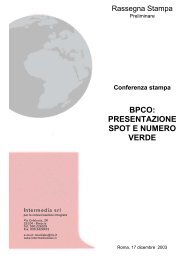
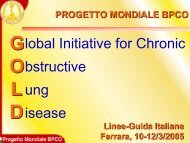
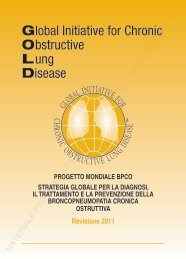
![Di Bari [NO].pdf - GOLD](https://img.yumpu.com/21544924/1/190x143/di-bari-nopdf-gold.jpg?quality=85)

